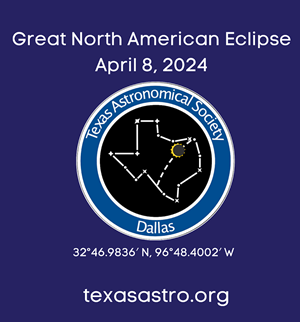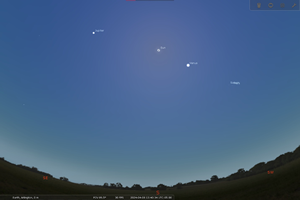


Total Solar Eclipse - April 8, 2024
Eclipse Outreach Kit
Home |
Doing Outreach |
Overview |
Resources
Planning |
Safety |
Photography | T-shirt |
Contact
The Texas Astronomical Society of Dallas wishes to partner and participate with individuals, groups, schools, towns, and all forms of organizations to celebrate the 2024 total solar eclipse. This majestic celestial event will be, for many, a once-in-a-lifetime opportunity that is certain to inspire wonder about our place in the universe. We in North Texas are fortunate to sit on the path of totality, and with this opportunity we will provide education to whoever desires it. Within this outreach kit, you will find in-depth information and ample resources to help you have a successful total solar eclipse viewing. If you have questions about any of the content provided, or require further information regarding the science of eclipses, safety, or planned events, please feel free to reach out to us at info@texasastro.org, and follow us on Facebook and Instagram to stay up to date on our club’s events, news, and general membership meetings. And of course you can become a member of TAS at texasastro.org. The TAS Eclipse Committee |
Click Here to DOWNLOAD OUTREACH KIT |
Texas Astronomical Society of Dallas |
Eclipse Overview
Eclipse Overview
- The Earth is ~4 times as wide as the Moon (Diameter)
- There are ~30 Earth diameters distance between the Moon and Earth
- The Sun is about ~100 Earth Diameters wide (109)
- The Sun is ~400 times the distance between the Earth and Moon
- The Sun is ~400 times as wide as the Moon
- The Moon moves through the sky about 12 degrees each day to the east.
For the April 8, 2024 Eclipse ...
- 31 million people live in the path of the total solar eclipse, almost 10% of the US population. This is three times more people than in the 2017 solar eclipse!
- 50% of the US population lives within 250 miles of the path of totality.
- On the day of the total solar eclipse (April 8th), the the five
naked eye planets will be in the sky.
- The moon will be seen between the sun and the earth
- Venus will be at -3.9 mag 15 degrees west of the sun.
- Saturn and Mars will be first magnitude 1.5 degrees apart about 35 degrees west of the sun. So, they will be visible that morning before sunrise, but difficult to see during totality.
- Jupiter will be at about magnitude -2.0, 30 degrees east of the sun and visible that evening after sunset.
- Comet 12P/Pons-Brooks will be about 6 degrees south-west of Jupiter between Jupiter and the Sun during the eclipse.
- Someday, we will no longer have solar eclipses as the moon is moving a few centimeters away from Earth every year.
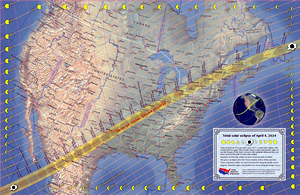
Image courtesy of NASA
Total Solar Eclipse happens roughly every year and a half somewhere on earth.
Why isn't there an eclipse every month?
Partial solar eclipse occurs at least twice a year. A total solar eclipse can only occur at the new moon phase. To see a solar eclipse, you have to be on the sunny side of earth, but the same spot on earth will see a total solar eclipse only about once every 375 years! There are at least two solar and two lunar eclipses (total or partial) every year visible somewhere on earth.
The reason why there is not a solar eclipse every month is because the moon's orbit forms a plane that is tilted about 5 degrees relative to the plane of the earth's orbit. This means that most of the time the moon is either above or below the plane of the earth's orbit. Eclipses occur only when all three, sun, moon, and earth, line up in a row.
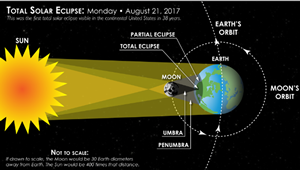
To see a lunar eclipse, you have to be on the nighttime side of the earth. A solar eclipse occurs on the daytime side of the earth. During a solar eclipse, the moon's shadow extends about 400,000 km (248,500 miles) past or behind the moon.
The moon's diameter (length of the straight line through the middle, widest part, of the moon) is about 400 times smaller than the sun's diameter; however, the moon is also 400 times closer to the earth than the sun. This makes the apparent size of the moon appear the same as the sun. When the moon passes across the middle of the sun, it just covers up the sun's disk in the sky as viewed from earth. The sun is completely blocked during a total solar eclipse. This is a total solar eclipse to an observer on the earth who is just under that moon's shadow.
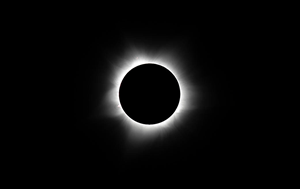
Image courtesy of NASA
In 2017, the moon's shadow (umbra) was about 70 miles wide and crossed 14 states across the United States from the Pacific Ocean to the Atlantic Ocean. The maximum eclipse was about 2 1/2 minutes of totality.
In 2024, the shadow of the moon will be about 100 miles wide
and will travel across the United States at about 2,000 miles
per hour.
Maximum
totality will last about 4 minutes and 20 seconds in Texas
and this duration also depends on where the observer is inside
the
path of
totality. The maximum possible length of totality is 7 minutes
32 seconds. The
2024 solar eclipse is the last total solar eclipse in Texas
for this century. The next total solar eclipse in the United
States
will be
in 2045.
|
Click Here to Download TAS Eclipse Outreach Kit About the Texas Astronomical Society of Dallas
Our annual membership dues are very reasonable and can be paid on-line using the PayPal link listed below. Membership is open to anyone having an interest in Astronomy and the night sky. Please visit the Club Information section for more on TAS. New members can download the New Members Handbook from the Members Only Section of the website. Follow @TASObserveJoin TAS or Renew your MembershipTAS is now 600 members strong....why not become a part of our family? Join TAS or Renew your Membership |
 |
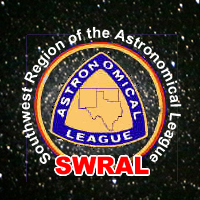 |
The Texas Astronomical Society of Dallas is a Member Society of the Astronomical League, and is an active participant in the Southwest Region of the Astronomical League |
The Astronomical League is a federation of astronomy clubs with member societies nationwide. The Astronomical League is the World's Largest Federation of Amateur Astronomers.
The Southwest Region of the Astronomical League consists of 28 member societies of the Astronomical League in the states of Texas, New Mexico and western Oklahoma.
